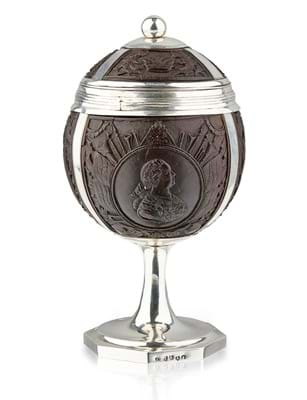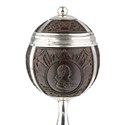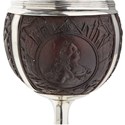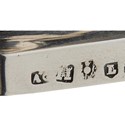Standing 7½in (18.5cm) high, it is finely carved with portrait busts of Catherine the Great, Empress Elizabeth and Tsarevich Peter, each surrounded by a display of arms and trophies of war. Given the subject and quality of execution, it was probably carved in Russia and later made its way to Scotland where Edinburgh silversmith Alexander Gairdner was commissioned to make the mounts (hallmarked 1791) and line the bowl in silver gilt.
Trading routes to the Baltic contributed to the success of Scottish merchants and encouraged many Scots (such as Dr John Roger, the Dumfriesshire-born physician to Catherine the Great) to seek their fortune in the Russian court.

A detail of the carved decoration of Catherine the Great appearing on the Russo-Scottish silver-mounted coconut cup that sold for £8000 at Lyon & Turnbull.
Gairdner would become one of Edinburgh’s longest-serving goldsmiths, working from 1754 (after his apprenticeship to William Aytoun) until his death in 1803, a career of some 49 years. He was one of a very small handful of Scottish goldsmiths who received royal patronage.
When on April 8, 1795, the Prince of Wales married Princess Caroline of Brunswick, The Caledonian Mercury noted that ‘Mr. Gairdner, Jeweller to his Royal Highness for Scotland, had a beautiful representation of the Prince’s feathers in small lamps on the front of his shop, which had a very fine effect, and attracted much notice’.
The coconut cup, described as ‘the property of a lady’ and estimated at £1500-2500 for the on August 17 auctopn, generated one of the strongest bidding battles of L&T’s Scottish silver sale when it sold at £8000 (plus 25% buyer’s premium).
A special feature devoted to Scottish and Irish provincial silver will appear in issue 2257 of ATG’s weekly print publication.











